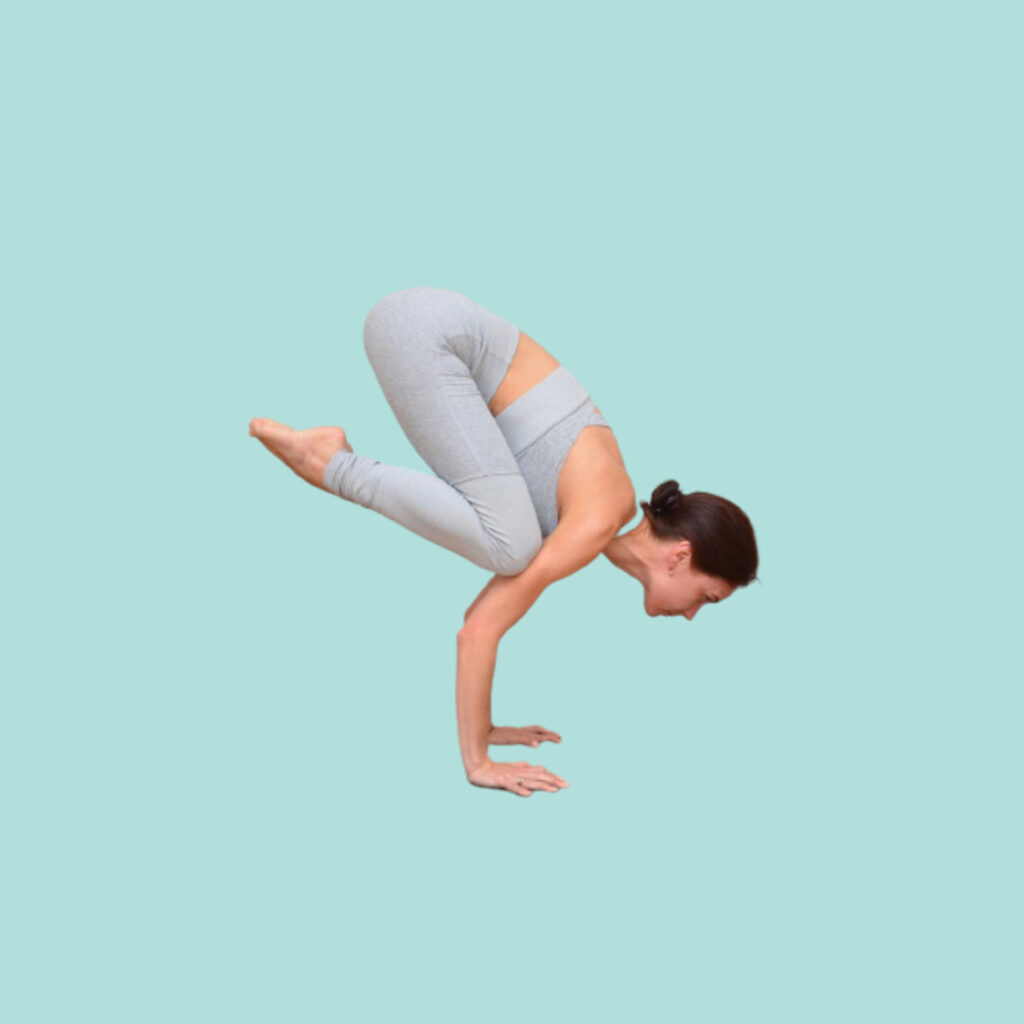Crow pose or Kakasana is a challenging arm balancing pose that uniquely develops your strength, flexibility, balance, and agility.
It strengthens your forearms, and wrists as well as your pelvis while stretching your upper back and opening up your groin. Working your forearms and wrists muscles is a great antidote to typing on a computer all day.
Plus, this challenging arm balancing pose offers an opportunity to face your fears and be playful in your yoga practice. Finding playfulness in your pose can help you reveal a sense of bravery and resilience.
Pose Information
| All names: | Crow pose, Kakasana |
| Sanskrit name: | काकासन |
| IAST: | Kākāsana |
| Pronunciation: | kuh-kuh-suh-nuh |
| English name: | Crow pose |
| Chakra: | Manipura (solar plexus) chakra |
| Pose type: | Arm balance pose, Strength, Forward-Bend |
| Pose level: | Intermediate level |
| Drishti point: | Down and forward toward fingertips (out to around 2 ft or 60cm) |
| Total time: | 20 to 60 seconds |
| Indications: | Balance, coordination, digestion, metabolism, upper back, groin, core, abdominal, arms, wrists, shoulders |
| Focus: | Forearms, wrists, shoulders, hips, abdomen, pelvis, groin |
| Counterposes: | Child’s Pose (Balasana), Adho Mukha Svanasana (Downward-Facing Dog), Bhujangasana (Cobra Pose), Uttanasana (Standing Forward Bend) |
| Preparatory poses: | Malasana (Garland Pose), Plank Pose (Adho Mukha Dandasana), Chaturanga Dandasana (Four-Limbed Staff Pose), Bakasana (Crow Pose), Dolphin Pose (Ardha Pincha Mayurasana) |
| Follow-up poses: | Padmasana (Lotus Pose), Gomukhasana (Cow Face Pose), Marjaryasana-Bitilasana (Cat-Cow Pose), Setu Bandhasana (Bridge Pose), Viparita Karani (Legs Up the Wall Pose) |
| Contraindications: | Wrist or shoulder injuries, high blood pressure, pregnancy, carpal tunnel syndrome, recent abdominal surgery |
Benefits of Crow Pose or Kakasana
Crow pose or Kakasana strengthens the wrists, forearms and abdomen while stretching your upper back. It improves balance and core strength. Mastering Crow builds your yoga confidence and balances the hand in many more poses. You will improve your awareness of where your body is in space and will increase control of your body.
1. Physical Benefits
- Builds physical strength and improves overall flexibility
- Strenghthen your arm, forearm, wrist (that makes more advance balance in your hands and your pose becomes easier)
- Core strength (that helps to tone your abs)
- Builds backbone strength and helps to gain flexibility
- Strengthens the abdominal muscles (that helps to improve your digestion)
2. Mental Benefits
Crow Pose or Kakasana improves your concentration and develops your focus. It works on emotional state by helping us conquer fear and allowing us to accept and embrace life with courage.
Steps to master in Crow Pose or Kakasana
Step-1: Warm-up poses
The Crow Pose or Kakasana, a symmetrical balancing arm support pose, where you bear full bodyweight on your hands, with your upper body work to support you and develop your core muscles and enhance your balance. So before mastering Kakasana, here the quick preparation work is done on the arms, core and hips, which are listed below in order of action.
1. Baddha Konasana or Bound Angle Pose
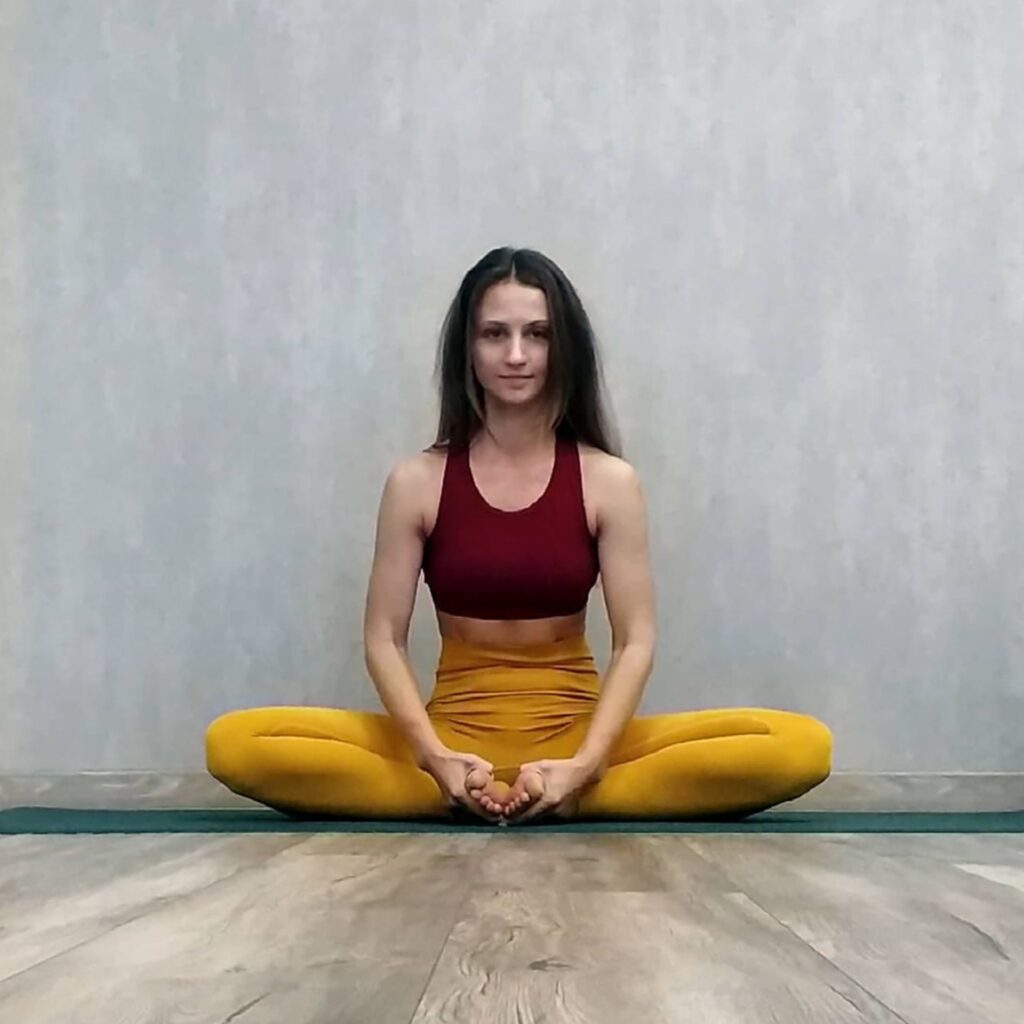
- From a sitting position, bring the bottoms of your feet together with the knees bent out to the sides, and interlace the fingers around the toes.
- Inhale and press your hips down and reach the crown of the head up towards the ceiling. Drop the shoulders down and back and press your chest towards the front. Press the knees down towards the floor to open your hips.
- Keep the back flat and chest open, exhale and gently pull your torso forward. Close your eyes and stare up at the third eye/sixth chakra.
- Breathe and hold for 3 to 8 breaths.
2. Wide Child’s Pose
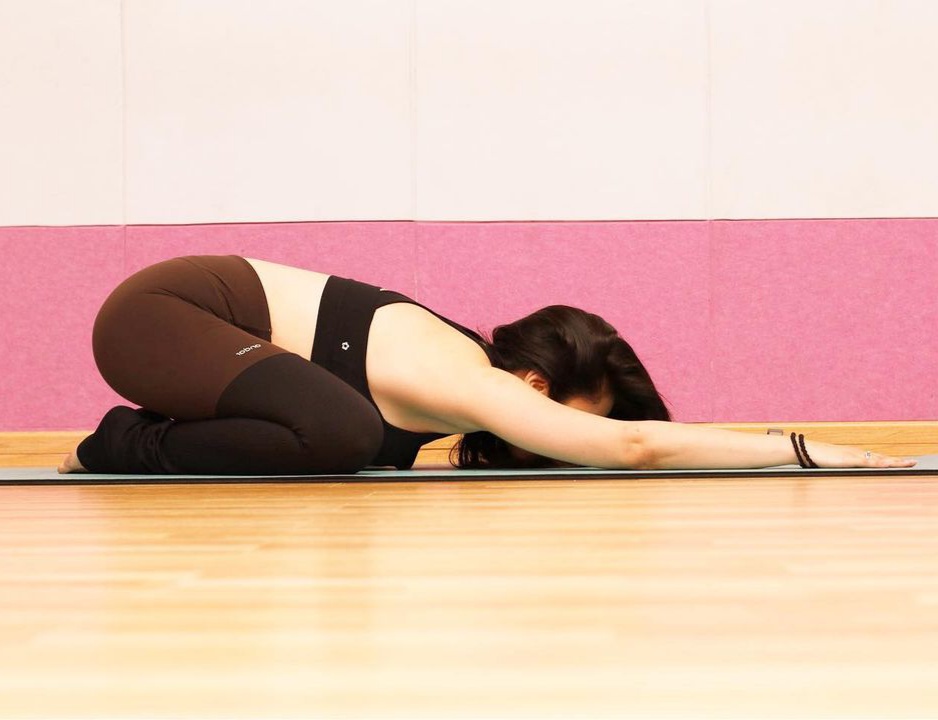
- After Baddha Konasana (Bound Angle Pose) bend the knees and place your feet behind you close to your buttocks and keep the knees spread apart and feel the stretch in your inner thighs.
- Inhale, and bring the trunk forward stretching to touch the floor with your chest and face and bring your arms stretched out in front of you.
This yoga pose will make them strong and flexible by opening your inner thighs, hip and lower back.
3. Garland Pose or Malasana
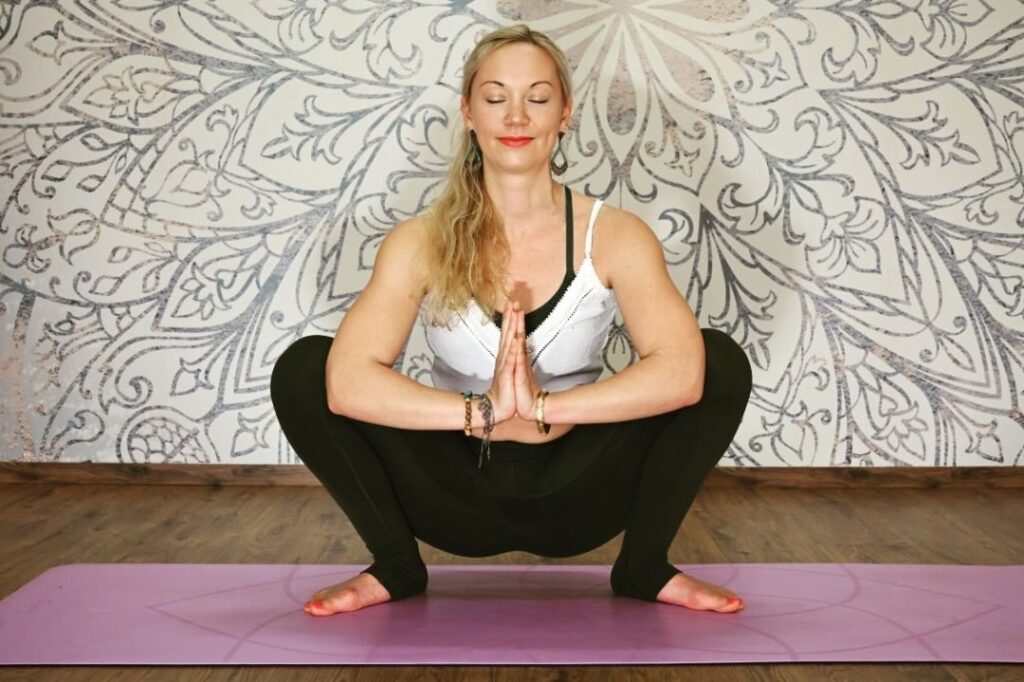
- Bring your body back from Prasarita Balasana, and move your feet out and place them on the floor in front of you with your knees bent.
- Inhale, place your palms on the floor to the side and raise your body up and balance on the feet and heels while bringing your arms in Namaste in front of you.
- Open the legs out spreading your knees and place your upper arm near the inner thighs and push your elbows out to open the thighs. Feel the stretch in your inner thighs and your hips.
- Keep the back straight looking up and with every exhalation take your elbows deep inside pushing the thighs to open wider.
Garland Pose or Malasana helps in balancing your body and improving the flexibility of your hips and legs. The blood circulation in the legs in Malasana will improve the strength of your calves and hamstrings.
4. Marjaryasana-bitilasana or cat-cow pose
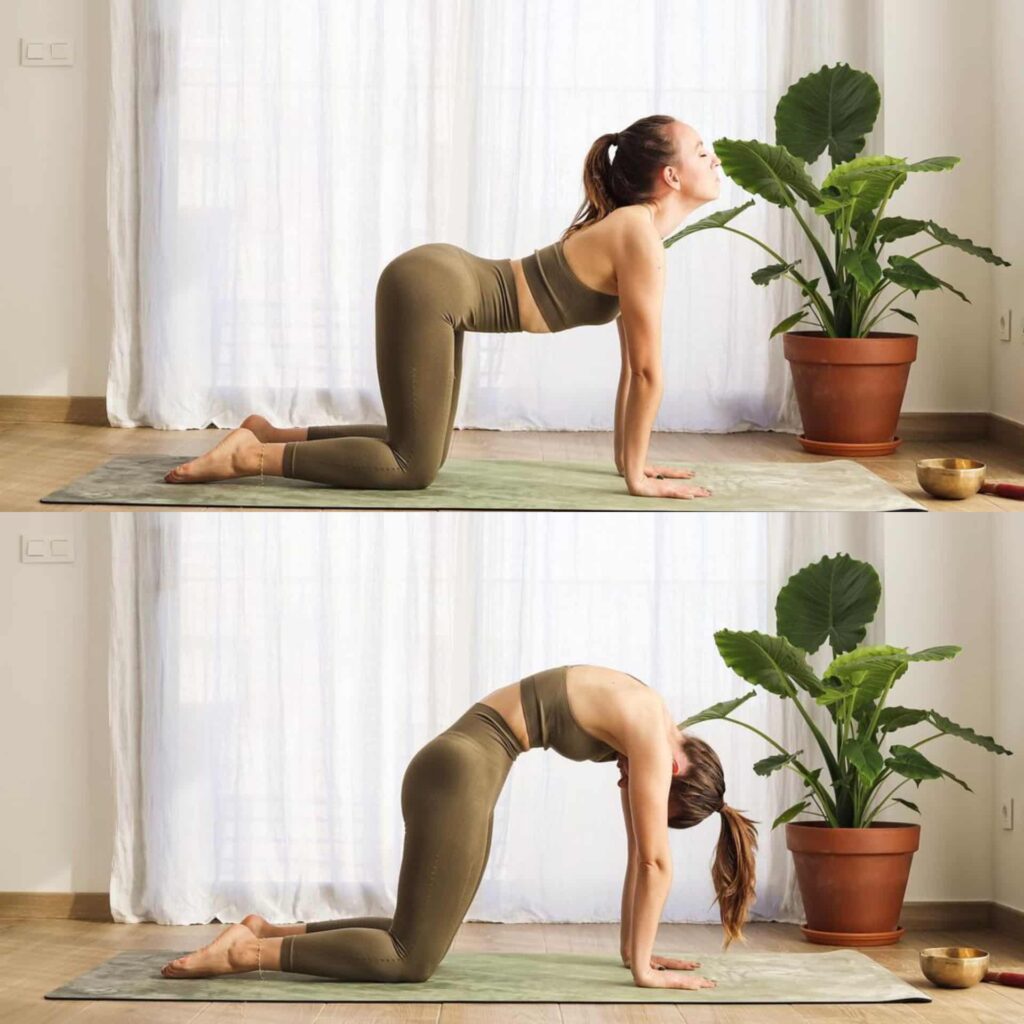
After Garland Pose, begin with your hands and knees under your shoulders and knees directly under your hips. Point your fingers at the top of the mat. Keep your shins and knees hip-width apart. Keep head in a neutral position and soften your gaze downward.
- Start by going into cow’s posture: When you release your stomach towards the mat, then exhale. Raise your chin and chest, and gaze up toward the ceiling.
- Widen your shoulder blades and pull shoulders away from your ears.
- Next, move to the cat pose. As you exhale, pull your stomach towards spine and round your back towards the ceiling. The pose should look like a cat pulling its back.
- Release the crown of your head towards the floor, but do not attach your chin to chest.
- Inhale, coming back to Cow Pose and then exhaling as soon as I return to Cat Pose.
- Repeat 5-20 times, and then sit straight with your torso back and relax.
Crow pose or Kakasana is practiced with a deep round spine – exactly what you make in a cat pose.
5. Downward Facing Dog Pose or Adho Mukha Svanasana
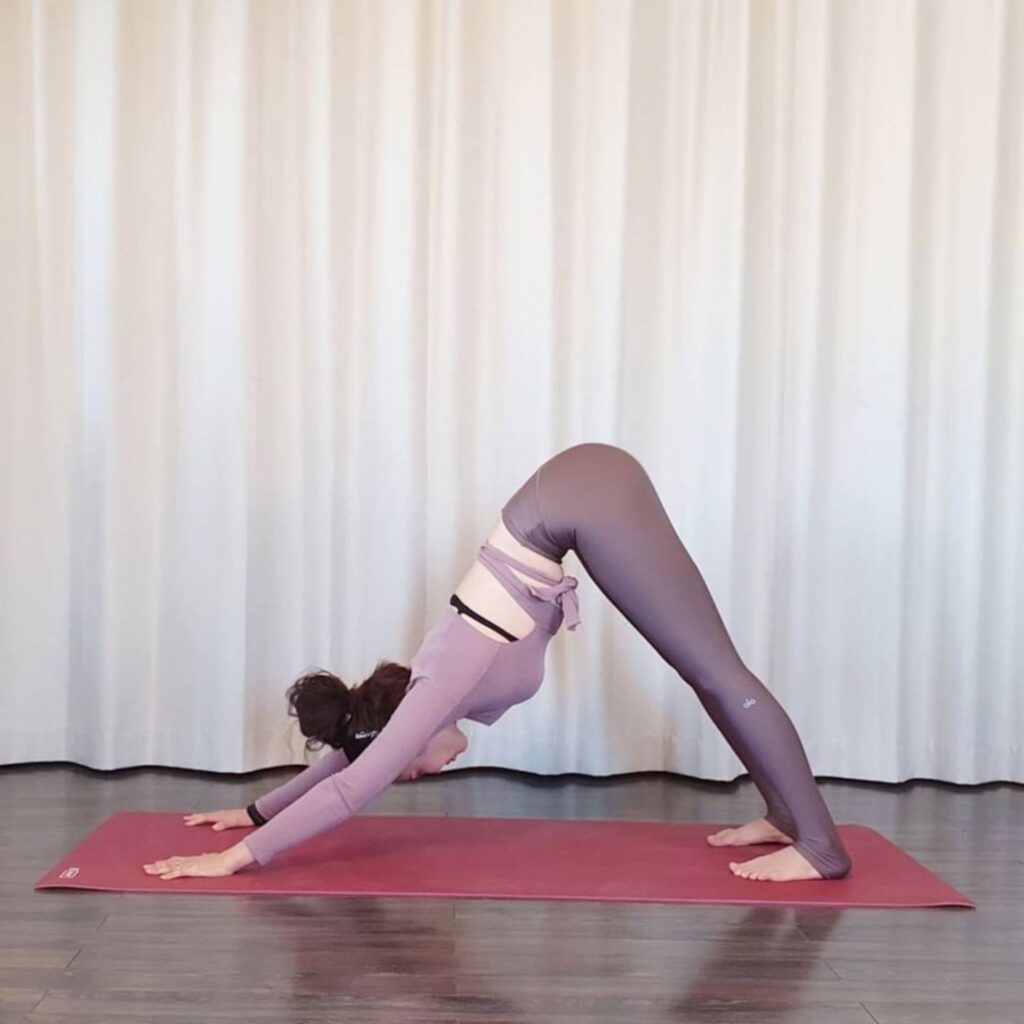
- Move from Marjaryasana-bitilasana (cat-cow pose).
- Here, take the entire body up placing your palms on the floor and your feet on the floor and raise your spine upwards bringing your neck and your head downwards.
- Stay in this pose for about 6 breaths and with every exhalation, take your spine upwards and your neck and face downwards and try to reach for the floor with the crown of your head.
Downward Facing Dog Pose or Adho Mukha Svanasana helps in strengthening the arms and the shoulders and also will improve your lower back with the spine stretched upwards.
6. Utthan Pristhasana or Lizard Pose
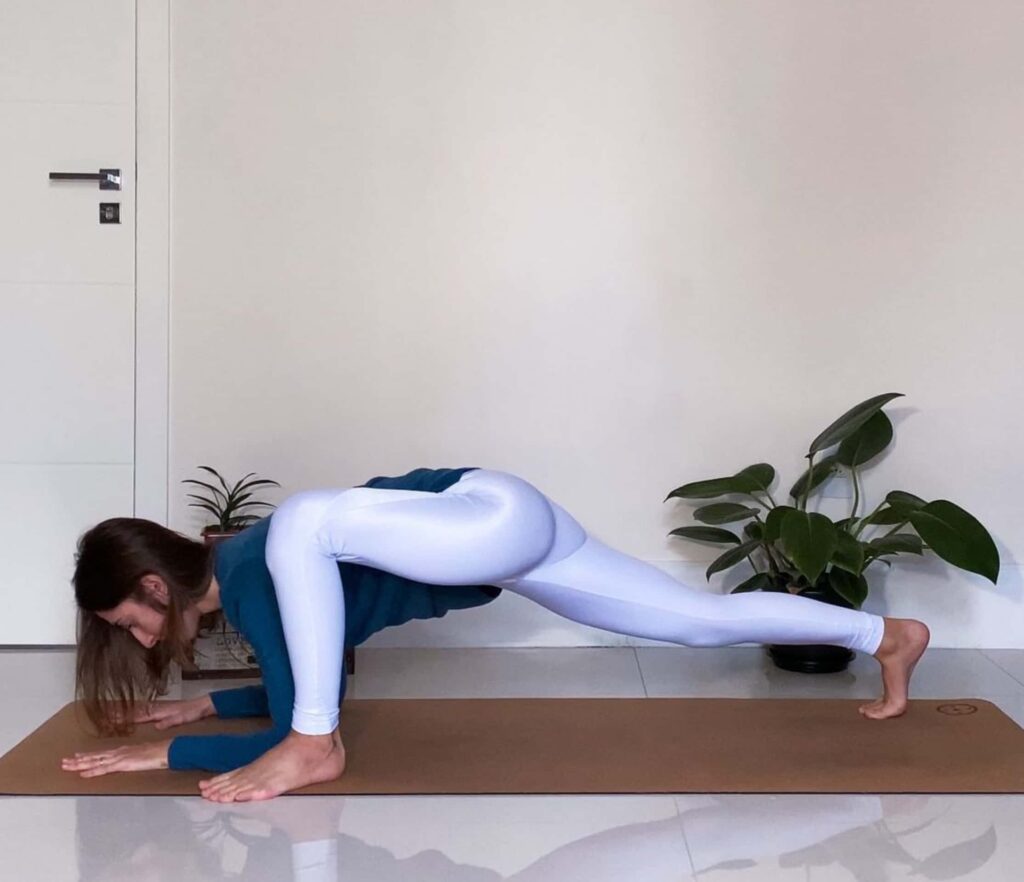
- From Downward Facing Dog Pose or Adho Mukha Svanasana, bring the body into Utthan Pristhasana or Lizard Pose, by step your right foot to the top of your mat outside of your right hand.
- Walk your back leg back as far as is comfortable, toes tucked under (Option to lift your back knee off the floor).
- Squeeze your feet toward each other to engage your hip and leg muscles.
- Reach your chest forward, keeping the spine long.
- If you have room, lower the forearms to a block or the ground. If the ground seems far away, place the hands on a block or a chair.
- Hold for 5 breaths, then release to tabletop and repeat on the other side.
In Crow pose (Kakasana) hip flexibility is the key factor, so the Utthan Pristhasana (Lizard Pose) is a great way to open your entire hip. Also, a little-known key of Crow pose (and just about every arm balance for that matter!) Is the extra power.
This variation of the lizard pose opens both hips and strengthens the addictors to connect you for the crow pose. Adductors are a group of muscles that run down the inner thighs. When activated, they pull the legs towards the midline of your body.
7. Phalakasana or Plank Pose
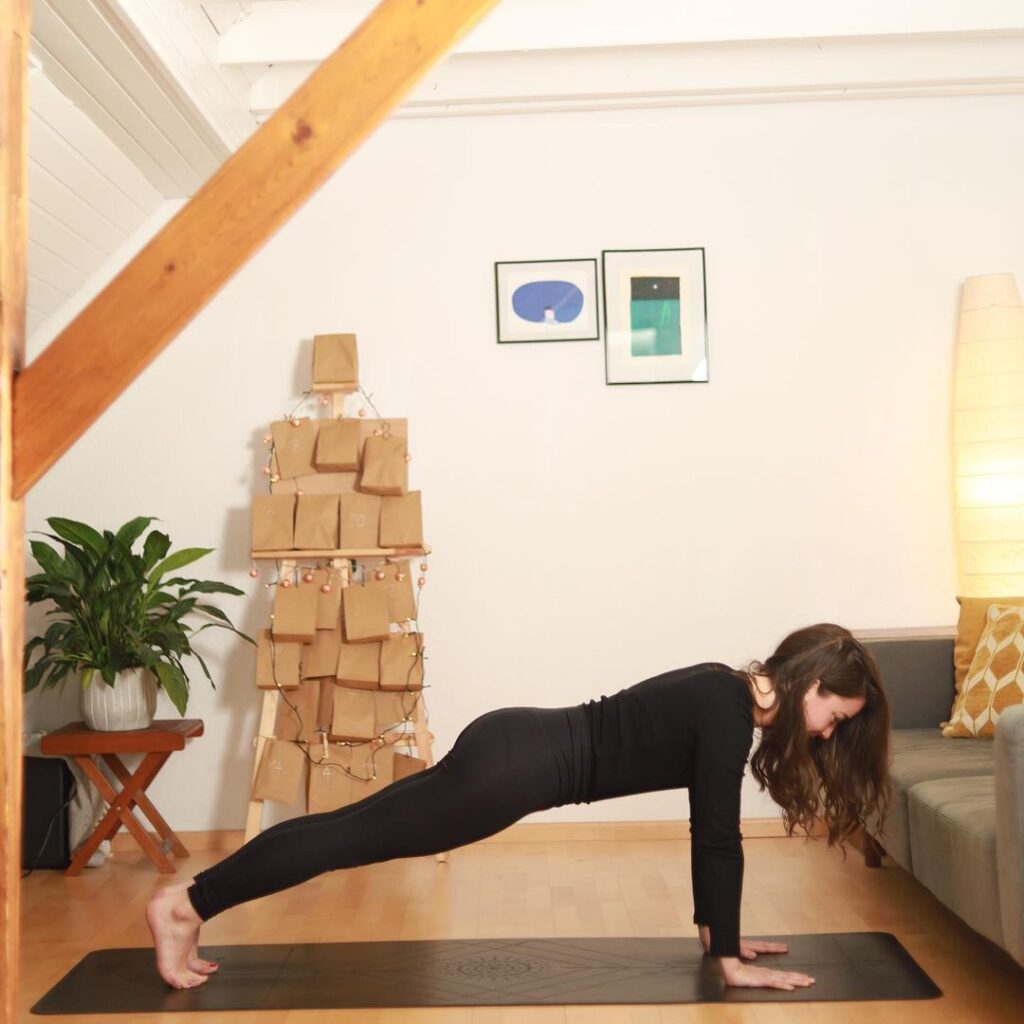
- From Utthan Pristhasana or Lizard Pose, bring the body into Plank Pose, by bringing your entire body at an angle with the floor with arms stretched out completely.
- The body should be form a triangle with the arms and the floor, thus putting weight not only at your shoulders and arms but using your core strength to remain in this pose.
- Inhale, take your body down and as you exhale, straighten your body out ensuring your shoulders and your wrists are in alignment.
- The longer you stay in this pose using your core strength, the stronger will your arms and shoulders become and so balancing in Crow Pose (Kakasana) will be easier.
8. Bhujangasana or Cobra Pose

- After Phalakasana (Plank Pose), take the body to Bhujangasana (Cobra Pose).
- Here your thighs rest on the floor and stretching your arms straight, pushing your palms on the floor, take your chest and head up and backwards.
- Take your body back like a snake and feel the stretch at your lower back and middle back opening the muscles and thus making the spine flexible.
- Hold for a few breaths and with every exhalation take your spine deeper backwards, pushing your chest and face out.
Bhujangasana (Cobra Pose) will assist you in preparing your body for Kakasana (Crow Pose) as your spine gets its expansion here and gains flexibility.
9. Chaturanga Dandasana or Four-Limbed Staff pose
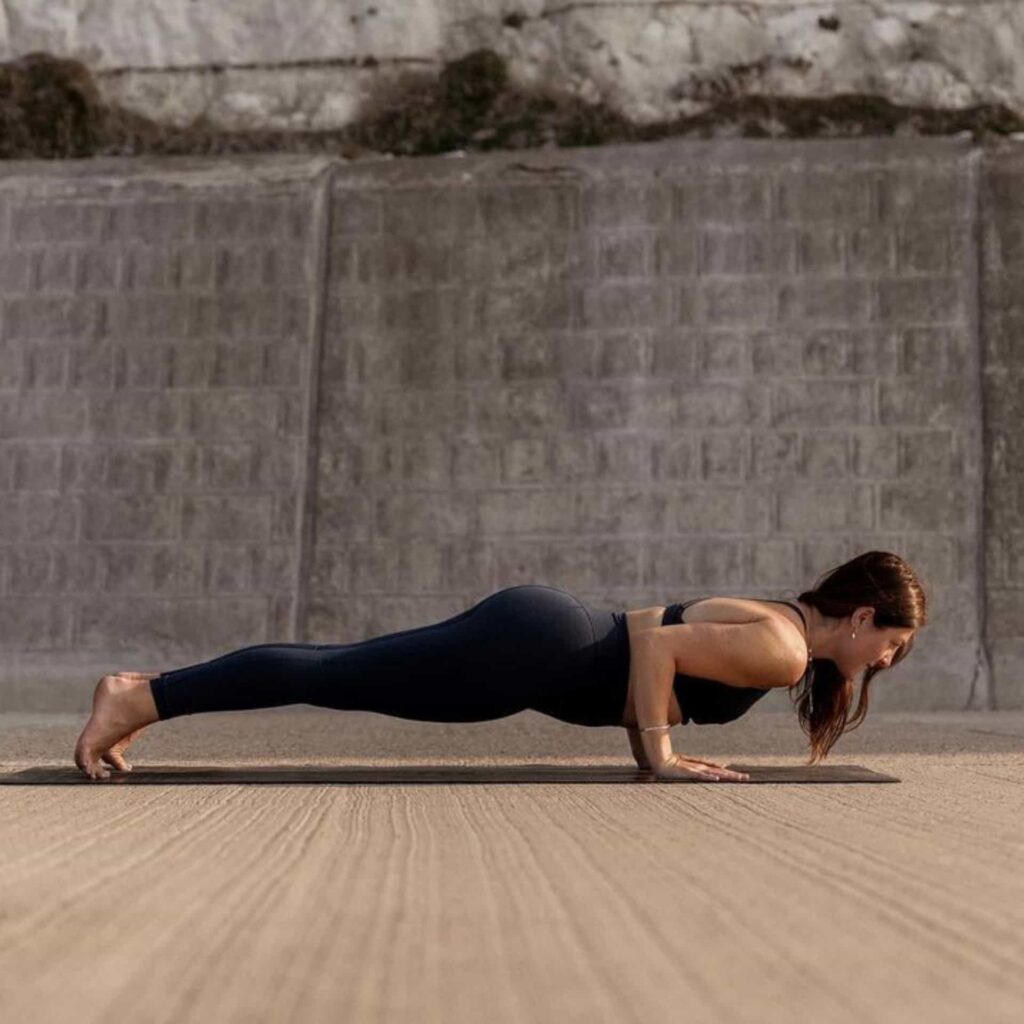
- After Bhujangasana (Cobra Pose), sit in vajrasana.
- Walk the hands forward and come in dandasana (plank pose) with the hands under your shoulders.
- Straighten the legs, till they are a few inches above the floor and parallel to it, with your toes turned inwards.
- On exhalation, bend the elbows until your shoulders are at the same height as the elbows.
- Exhale, come up to plank pose.
- Exhale, sit in vajrasana.
It’s no secret that arm balances require a great deal of arm strength, and there is no better pose to develop significant your arm strength other than Four-Limbed Staff pose (Chaturanga Dandasana). To mastering Crow pose (Kakasana), it can open the door to a world of arm balances for you.
10. Ardha Navasana or Half Boat pose (Extended Boat Pose)
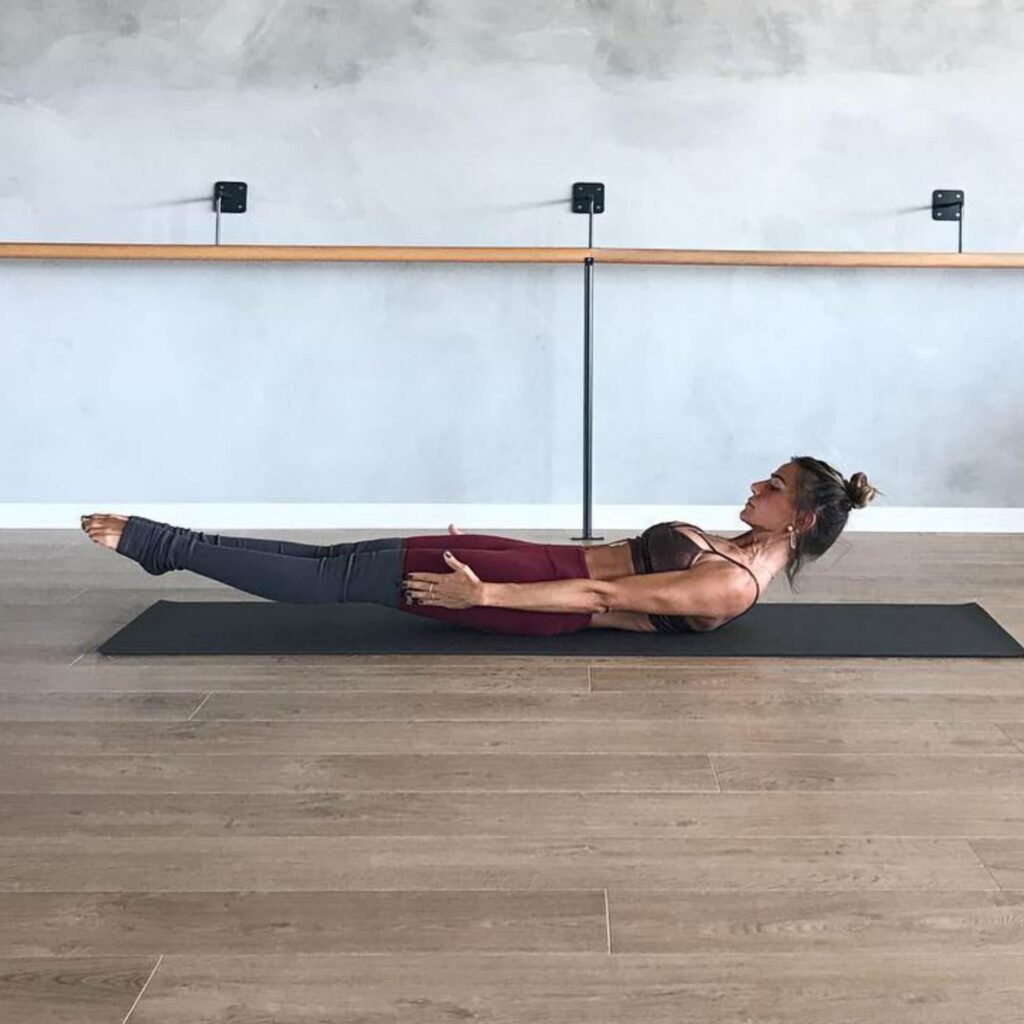
- After Chaturanga Dandasana or Four-Limbed Staff pose, seat on the mat with your knees bent and your feet flat on the floor.
- Place the hands behind your knees and lengthen your spine, with the shoulders dropping away from the ears.
- As you inhale, engage the core to slightly lean back to about a 45 degree angle, lift the feet off the floor, and bring the shins parallel to the mat.
- Balance on the sit bones and activate the inner thighs by hugging to your midline.
- Release your hands from behind the knees, and interlace the fingers behind the head.
- Draw the elbows away from each other, and strive to keep them exactly as they are as you stretch your legs forward and lower the torso until you hover just above the mat.
- Hold for 5 deep breaths, rest, and then repeat 2 more times.
Core strength is key for any arm balancing pose, and Kakasana is no exception. Ardha Navasana or Half Boat pose, works to strengthen the harder-to-reach lower abs and also reinforces the rounded spine position that is needed to practice Crow pose (Kakasana).
11. Surya Namaskar
The whole body should be nice and warm, so after practicing the above 10 yoga pose in sequence move through your Surya Namaskar, and finish your standing order with ‘Goddess Mudra‘ to bring stability to the hips and thighs!
Step-2: Crow pose or Kakasana
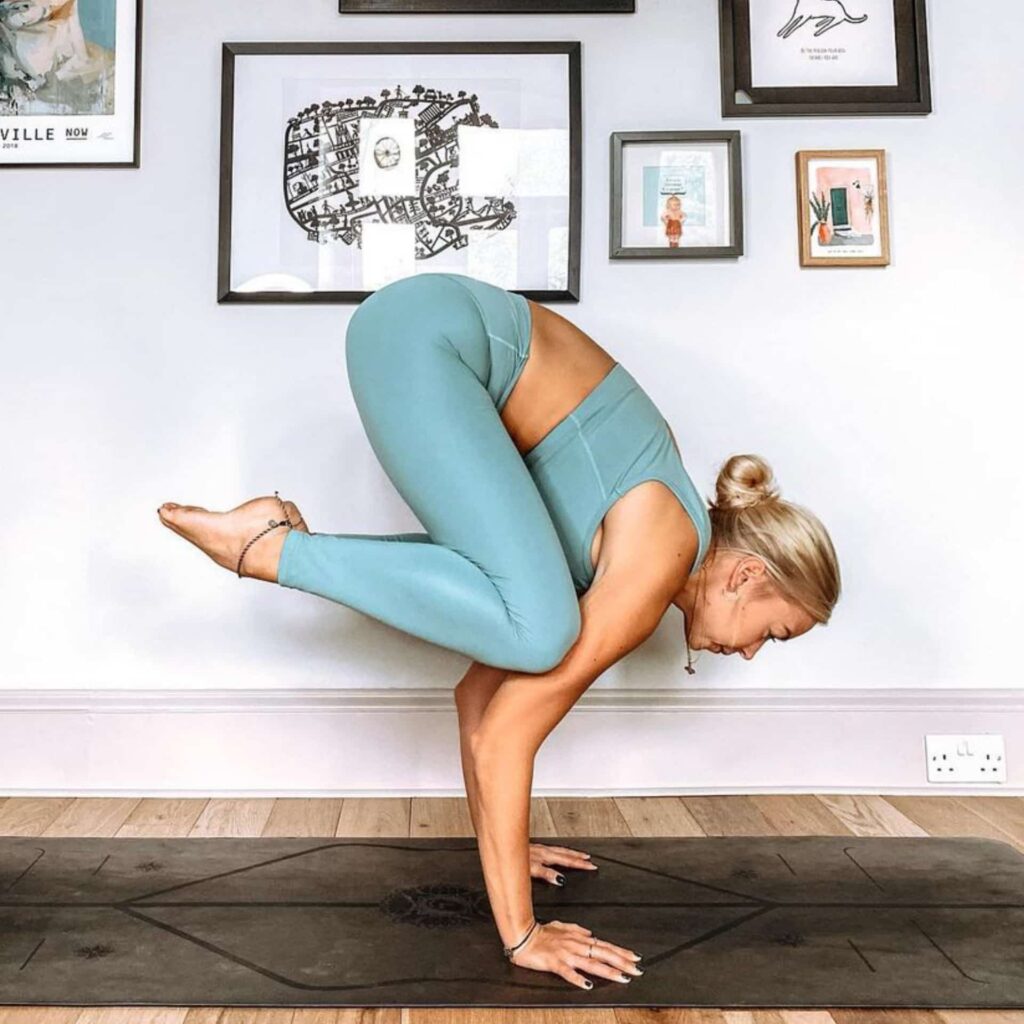
- Begin by standing in Tadasana (Mountain pose). Stand tall and straight with the feet separated enough to feel stable. Establish a solid connection with the floor by shifting the weight distribution so that it is equally divided between the base of the big toes, the base of your little toes, and both left and right sides of the heels.
- Squat until you can place the hands flat on the floor, setting them shoulder-width apart. Anchor the palms on the floor about 12 inches in front of the feet. Spread the fingers and press the top joints of each finger into the floor.
- Bend the elbows back, keeping them straight. Raise the body onto the balls of the feet and spread the knees open until they are aligned with your upper arms. Gently bring the knees into the backs of the upper arms and shift your body weight onto the hands, raising your head as you move forward.
- Support the body on bent toes. Raise your one foot off the floor followed by the other. Pull the knees toward the midline and pull the feet toward your hips.
- Stay in this position for 20-60 seconds. To releasing yourself from this pose, shift the bodyweight back until both of your feet are back on the floor.
- Rise to stand in Tadasana (Mountain pose). Stand tall and straight with the feet separated enough to feel stable. Establish a solid connection with the floor by shifting the weight distribution so that it is equally divided between the base of the big toes, the base of your little toes, and both left and right sides of the heels.
Anatomy and Physiology Notes: Skeletal joint actions, Muscular joint actions and Breathing
In the Kakasana (Crow poses), common factors are flexion of the thoracic spine, abduction of the scapulae, and extension of the cervical spine. These actions require precision and strength in the muscles of your spine to achieve cervical extension without engaging the trapezius, which interferes with the action of your scapulae and your arms.
Although your knees initially widen to come into this position, the final action of your legs is adduction, to hug the knees to the sides of your upper arms or outer shoulders.
1. Skeletal and Muscular joint actions
- Arms: The triceps engage as you press into the floor, resisting more elbow flexion. Your elbow flexors help to stabilize the joints. Your wrist extensors extend your wrists and wrist flexors stretch while stabilizing your hands in position. The structure , pectoralis muscles, and serratus anterior muscles stabilize the body in position.
- Wrist strengthening: The arm balances strengthen your wrist extensors, which can often be weak due to lack of use. Likewise, your wrist flexors is also tight from typing, texting, and grasping things. This action stretches them to assist prevent carpal tunnel syndrome. However, if you currently have wrist issues, this amount of weight bearing is maybe too much.
- Neck: Your cervical extensorsengage to look forward about 2 ft (60 cm) while the cervical flexors are stretching.
- Cerebellum activation: Crow pose (Kakasana) activates your cerebellum, which is responsible for muscle memory. It detects shifts in balance, coordinates smooth muscle and eye movement, and helps the body learn complex movement patterns that become habit with practice, like riding a bike or getting into Crow pose.
- Torso: The abdominals engage to flex your spine, while the spinal extensors, trapezius, rhomboids, and latissimus dorsi stretch. Your hip flexors—particularly your iliopsoas—engage. Your serratus anterior muscles stabilize your scapulae.
- Thighs: Your hip flexors engage to flex the hips. Your hamstringsflex your knees and your quadriceps stretch. The adductors are recruited to adduct and stabilize your hips and thighs.
- Lower legs: Your plantar flexors engage to point your toes, while the dorsiflexors slightly stretch—particularly the tibialis anterior.
2. Breathing
Since the thoracic region is maintained in flexion, the breath movement in your rib cage is minimized in this pose. The lower abdomen is also somewhat stabilized by the deep abdomen and hip flexor action, but the upper abdomen is relatively free to move.
Crow pose or Kakasana for beginners
First time getting into Crow Pose (Kakasana) is special to many people, and it was definitely for me. This was the first weapon balance I had received in a yoga class, and I will never forget that perfectly capable feeling of being strong and flexible in equal parts. For the first time, instead of feeling like a tough newbie, I realized that my body was actually capable of some amazing things that I had seen other yogis do. The simple way to try and get it gives me the confidence to keep it up. Self confidence is often half the battle in yoga and in fact we need to work to overcome our obstacles.
To gain crow pose, use these modification practice methods and arouse hope and motivate yourself to practice.
- Gain Crow pose using two sets of blocks
- Gain Crow pose using two blocks stacked on top of each other
1. Gain Crow pose using two sets of blocks
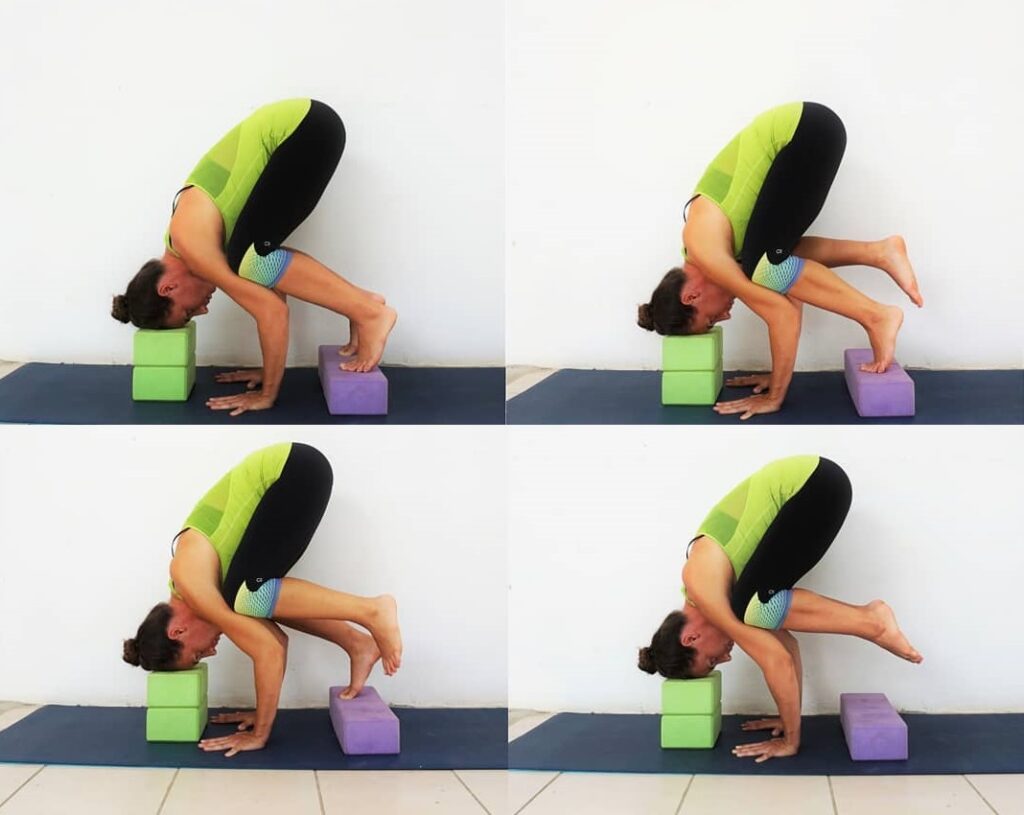
- Stack two blocks on top of each other for your head and place two side by side for the feet.
- Bring the hands to the floor behind the stacked blocks.
- Place the balls of your feet on each of the side by side blocks.
- Lift onto your toes and place the knees on your triceps as close into your underarms as you can. Press through your hands and lean forward, resting your forehead on the stacked blocks.
- Engage your core and slowly bring one foot off the blocks at a time – this is called toe tapping.
- Practice this until you gain enough your core and arm strength to fully lift your both feet off of the blocks.
2. Gain Crow pose using two blocks stacked on top of each other
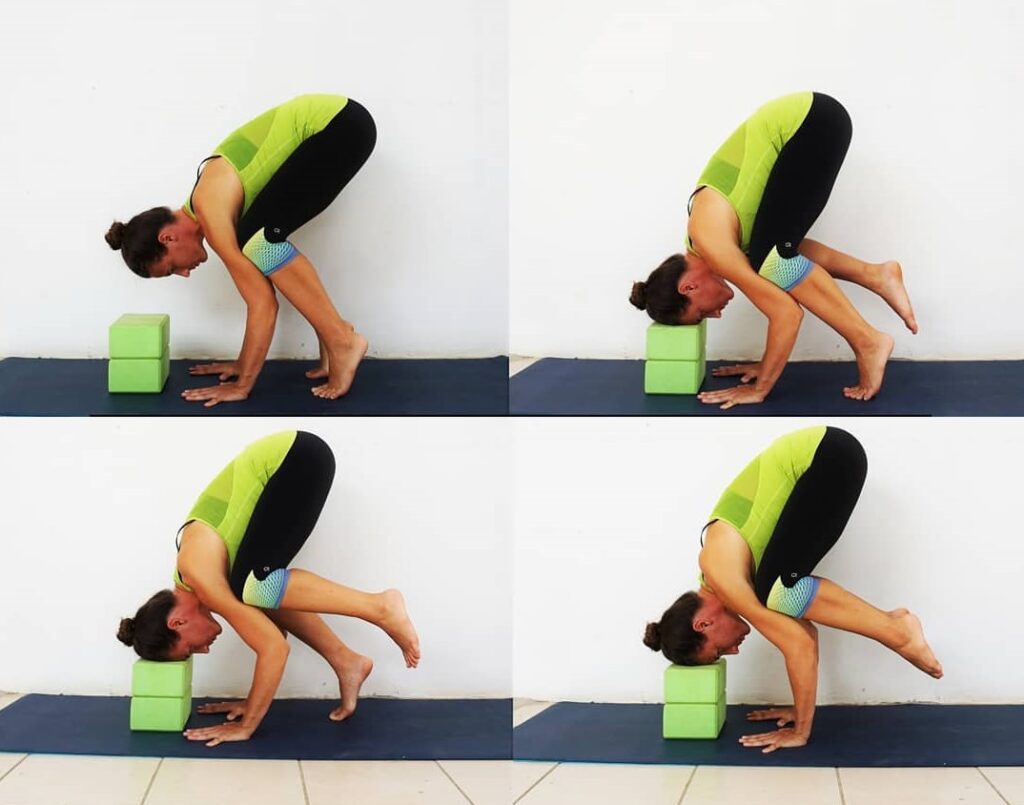
- Place the hands on the floor behind them. Come onto the balls of the feet, bringing your knees to the underarms resting them on your triceps.
- Press through the hands, engage your core and toe tap on both sides.
- When you gain enough your arm and core strength, lift your both feet off the ground.


